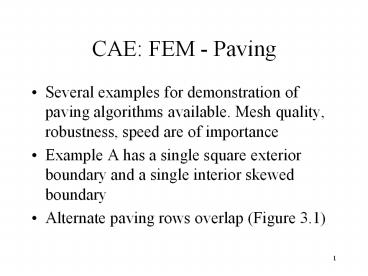CAE: FEM - Paving PowerPoint PPT Presentation
1 / 16
Title: CAE: FEM - Paving
1
CAE FEM - Paving
- Several examples for demonstration of paving
algorithms available. Mesh quality, robustness,
speed are of importance - Example A has a single square exterior boundary
and a single interior skewed boundary - Alternate paving rows overlap (Figure 3.1)
2
Paving Examples
- Two exterior paving boundaries are formed
- One completely paved before the other boundary
- Continue to close all exterior boundaries
- Cleanup does little to modify nodes. Boundary
sensitivity is seen. Irregular nodes moved to
interior
3
Paving Examples
- Example B shows an exterior boundary and two
interior boundaries (Figure 3.2) - Mesh densities very different on concave
boundary. Upper slot matches concave boundary in
density - Lower slot matches rest of exterior boundary
4
Paving Examples - transition
- Exterior boundary has non-uniform node spacing.
Concave arc twice as dense as other portions of
boundary - Dissimilar element sizes overlap during paving.
Seaming connects nodes nicely - minimum of irregular nodes are formed
- large elements are reduced in size with wedges
5
Paving Examples - transition
- Boundary sensitivity is demonstrated. Meshes near
boundaries are well-formed - Example C demonstrates an odd shaped exterior
boundary (Figure 3.3) - Two sharp corners found in exterior
- Interior boundary very close to exterior boundary
6
Paving Examples cleanup
- Sharp angles found and cleanup will be required
to create good quality elements - The seam created in first row blunts sharp
corners and regular mesh results in later steps - Distorted elements formed due to mesh overlap.
Remains with mesh for most of the steps
7
Paving Examples gradation
- Cleanup eliminates most bad elements in example
C. - Example D has simple exterior boundary. No
interior boundaries. - Extreme gradation in density of nodes is applied
along the boundary. (figure 3.4) - Nodes along notch at upper right are 20 times
denser than the rest of the boundary.
8
Paving Examples Large gradations
- Paving handles large gradations
- disproportionate mesh rows interact and the
resulting meshes are kept valid - cleanup dramatically improves quality
- dense mesh near smaller meshes. Large element row
moves farther from boundary than a small element
row
9
Paving Performance quality
- Goal is to generate all quad (4 nodes) elements
in any arbitrary geometry/topology - quality of generated mesh is critical (aspect
ratio, distortion, interior angle etc.,) - robustness of algorithm is critical
- speed of mesh generation is critical
10
Paving Performance quality
- Meshes are boundary sensitive, orientation
insensitive, and minimize placement of irregular
nodes (less than or greater than 4 elements at a
node) - distortion measure if used to check quality
- other factors such as type of analysis, element
size, loading affect simulation results.
11
Paving Robustness
- Example A has distortion D0.02 (average) and
D0.26(max) - Example B has distortion D0.09 (average) and
D1.09(max) - Example C has distortion D0.11 (average) and
D1.13(max) - Example D has distortion D0.30 (average) and
D1.96(max)
12
Paving Robustness, Speed
- Robustness is quite good upto 301 transition
ratio (need adjustment of nodes on permanent
boundary) - Long and thin sections proceed quicker than large
open boundaries (results in many small outer
boundaries for former case) - Linear relation with number of nodes and cpu
seconds. Geometric complexity counts
13
3D meshing tet-meshing
- Tetrahedral meshes are generated from a closed
set of meshes - 3D meshing techniques for tet-meshes are fully
automated - hex meshers are relatively harder to automate and
a very few are available in the market
14
3D meshes - hex/tet meshes
- Paper on hex/tet meshing benefits
- tet 10 element formulations are shown to be
comparable in performance to hex 20 elements on
simple studies - Adaptive meshing with h-method meshing as well as
p-method meshing show good potential for
automation
15
Fergusons vs. Bezier
- Form of the curve/surface equation
- physical meaning of vector coefficients
- bezier more suitable for curve design rather than
curve fit - bezier contained within characteristic polygon
(hull convexity property) - criteria for loop formation varies
16
Fegusons vs. Bezier
- Corner vertices lie on bezier surface.
- Bezier suited well to study conic curves and
surfaces - Matrix notational differences

